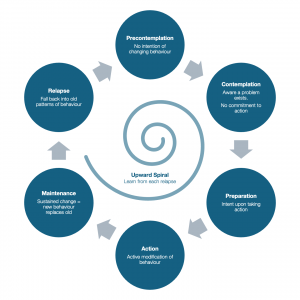Change rarely follows a straight line. It spirals. We set intentions, wrestle with ambivalence, take action, stumble, regroup, and sometimes circle back to where we started. Traditionally, these “stages of change” are seen as a progression where stalling or slipping back is framed as weakness or failure. But what if every stage, even the pauses and relapses, was a positive part of growth?
Drawing on the Transtheoretical Model of Change (Prochaska & DiClemente, 1983), growth mindset research (Dweck, 2006), and Carl Rogers’ person-centred theory (1957), let’s reframe the cycle as a hopeful process where every stage is both necessary and valuable.
The Stages of Change (Reframed With Positivity)
The Transtheoretical Model describes five main stages (sometimes six, if you include “termination” as a final endpoint). People move through these repeatedly, often recycling many times before change is sustained.

1. Precontemplation
The Packet of Seeds
Often labelled “denial,” this stage is better understood as incubation. People here may not yet see change as relevant or necessary, but that doesn’t mean nothing is happening. Seeds are being planted through gentle exposure to new perspectives, role models, or supportive conversations. This stage is about conserving energy until safety and readiness align.
Reframe: Pre-contemplation is not ignorance; it’s a resting stage before curiosity sparks.
2. Contemplation
The Greenhouse of Growth
This is the stage that gets unfairly dismissed as procrastination. In reality, contemplation is deep cognitive work. It’s the period where ambivalence is explored, values are weighed, and possible futures are imagined. Research shows many people spend long periods here, and that’s not wasted time; it’s a sign of maturity, not weakness.
Reframe: Contemplation is not being stuck; it’s a rehearsal space where change is mentally trialled and prepared.
3. Preparation
Supports and Seed Pots
Here, people begin planning concrete steps. It could be researching resources, setting dates, or making small adjustments. Bandura’s self-efficacy theory reminds us that small mastery experiences build confidence and momentum (Bandura, 1977).
Reframe: Preparation is not dithering; it’s the careful design of scaffolds for future success.
4. Action
Pruning and Watering
This is the visible stage of change, when behaviour shifts. It’s easy to think action is the only “real” part of the cycle, but action is simply the testing ground. It provides feedback: what works, what doesn’t, and what still needs adjustment.
Reframe: Action is not the finish line; it’s where growth gets tweaked and tested.
5. Maintenance
The Skilful Gardener
Instead of constant vigilance against relapse, think of maintenance as integration. It’s when new habits become part of identity. People start saying, “I’m a non-smoker” instead of “I’m trying to quit.” Maintenance isn’t static; it’s ongoing refinement.
Reframe: Maintenance is not survival mode, it’s the joyful consolidation of a new self.
6. Relapse (or Recycling)
The Cucumbers Didn’t grow This Time
Relapse is often framed as moral failure. In reality, relapse is diagnostic data, a chance to identify triggers, gaps in skills, or environmental challenges. DiClemente (2022) emphasises that relapse is best seen as a normal part of the cycle and an opportunity for learning. (I need a hose and a thermometer for a successful crop next time)
Reframe: Relapse is not falling back; it’s feedback for a stronger next attempt.
Growth Mindset and Change: Why Language Matters
Carol Dweck’s research shows that when we view abilities as malleable rather than fixed, we persist longer, recover more quickly, and learn more deeply. Applied to the change cycle, this means:
- Fixed mindset: “I failed, so I can’t change.”
- Growth mindset: “I slipped, but I learned what to do differently.”
The language we use around change matters. Each stage is a learning opportunity, not a pass/fail test.
How Carl Rogers and Person Centred Therapy Fits the Change Cycle
Carl Rogers believed in the actualising tendency: our natural drive toward growth and fulfilment. But this tendency needs the right conditions. Rogers identified three:
- Empathy (being deeply understood),
- Unconditional Positive Regard (acceptance without judgement),
- Congruence (authenticity in the relationship).
These conditions mirror what helps people thrive in the change cycle:
- In contemplation, empathy, and unconditional acceptance reduce shame and defensiveness.
- In preparation, congruence helps realistic planning.
- In action, empathy supports resilience.
- In relapse, unconditional positive regard allows learning rather than self-blame.
Therapy provides the soil in which the natural drive toward growth can take root and flourish.
The Optimum Conditions for Change
When we blend the Transtheoretical Model, growth mindset, and Rogers’ theory, the conditions for effective change become clear:
- Psychological safety — an environment free from shame or judgment.
- Self-efficacy support — building small wins that grow confidence.
- Stage-matched support — interventions tailored to where someone really is.
- Growth-mindset framing — setbacks as learning, not failure.
- Environmental design — shaping surroundings to support new behaviours.
- Relapse debriefs — structured, shame-free reviews that turn slips into insights.
- Meaning and identity work — imagining the “new self” as part of integration.
- Social support — role models, encouragement, and accountability.
Practical Takeaways (For Therapy and Beyond)
- Contemplation is progress: it’s deep work, not wasted time.
- Relapse is feedback: each return to the cycle is an upgrade, not a reset.
- Therapeutic conditions matter: empathy, authenticity, and acceptance make each stage safer and more effective.
- Growth mindset fuels persistence: change isn’t a straight line, but a spiral that gets stronger with each turn.
Closing Thought
Change isn’t about forcing yourself up a staircase; it’s about trusting the spiral. Every stage is purposeful, even the pauses, even the relapses. When we reframe the cycle through positivity, growth mindset, and self-compassion, change becomes not a battle against constant feelings of failure, but a steady movement toward wholeness and the change we seek.
We often notice the cycle most in our everyday “failures”: scrolling mindlessly through social media when we promised ourselves an early night, reaching for the chocolate we swore we wouldn’t buy, or feeling stuck in a rut when our goals seem to slip out of reach. In these moments, the instinct is to launch into negative self-talk: “I have no willpower. I’ll never change. I’ve ruined it again.”
But what if instead of piling on shame, we simply paused and asked: “Where am I on the change cycle right now?”
By locating ourselves on the cycle, we turn what looks like failure into information. Maybe we’re back in contemplation, reflecting, weighing options, testing our readiness. Maybe we’re in relapse, learning firsthand about our triggers and obstacles. Maybe we’re in preparation, gathering courage, but not quite stepping forward yet. None of these are failures. The only real failure would be never to step onto the cycle at all.
This shift matters because the cycle is compassionate by design. It allows us to step back at any stage and in any capacity. We can re-enter with curiosity rather than criticism. Instead of saying, “I blew it,” we can reframe it to, “I’ve gathered new information about myself.” (For example, “Social media helps me relax, sometimes I need chocolate, and it’s okay. Or maybe I’m too tired to cook because of work, children, exercise, and a takeaway isn’t me failing.”) Small snippets of understanding inform the spiral. What stage am I in, and what’s the next small step?
Self-kindness is the fuel that keeps us moving. When we work with ourselves instead of against ourselves, each stage becomes a partnership rather than a punishment.
Take confidence as an example:
- “I want to feel more confident.”
- Right now, I might be in contemplation, thinking about what confidence means to me and imagining what life could look like if I felt it.
- To move toward action, I could try a small experiment, perhaps speaking up once in a meeting or practising positive self-talk in the mirror.
- I anticipate obstacles: maybe self-doubt will creep in, or I’ll avoid opportunities that stretch me.
- If that happens, I remind myself: relapse is not defeat. It’s an invitation to review what happened, adjust my plan, and step back into the cycle.
This type of thinking creates alignment. It transforms the inner critic into a curious ally. It reframes the cycle not as a test we can fail, but as a map we can rejoin at any time.
Success, then, isn’t about perfection. It’s about recognising what we want, understanding what each stage offers us, and returning to the cycle with compassion whenever life knocks us sideways.
References
- Prochaska, J. O., & DiClemente, C. C. (1983). Stages and processes of self-change of smoking: Toward an integrative model of change. Journal of Consulting and Clinical Psychology, 51(3), 390–395.
- DiClemente, C. C. (2022). Relapse on the Road to Recovery: Learning the Lessons of Relapse.
- Dweck, C. S. (2006). Mindset: The New Psychology of Success.
- Rogers, C. R. (1957). The necessary and sufficient conditions of therapeutic personality change. Journal of Consulting Psychology, 21(2), 95–103.
- Bandura, A. (1977). Self-efficacy: Toward a unifying theory of behavioral change. Psychological Review, 84(2), 191–215.







